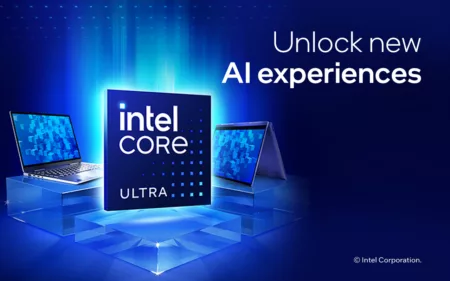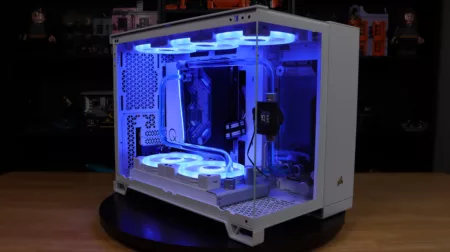Gaming laptops have been for the most part of their existence, become the complete anti-thesis of portable gaming. The market right now is alive with the top manufacturers competing heavily in this segment offering variations of a single design and that single design is, as far as portability and mobile goes, not that portable. Full-pledged gaming laptops are thick, heavy and Alienware certainly did a good job imprinting their brand as the reference for this segment but that GIGABYTE isn’t having none of that. Today we got GIGABYTE’s gaming notebook aimed at, well, gamers which heavily detracts from the normal form of gaming laptops and stick to a more conventional notebook design. This is hyped-up stuff we got right here so let’s get rockin’ and let’s make this extremely showy!
Â
A couple of months back, we were invited to a product launching by GIGABYTE in their new notebook offerings that’ll hit the local market. GIGABYTE was pretty adamant about two things during that launch: 1) their products are portable and 2) they offer much more than the competition. Certainly fighting words from GIGABYTE and we’ve certainly seen they manage to stick to their promise with our recent review of the U2442V Ultrabook. Now we move on over to their gaming line, the performance flagship of the GIGABYTE Notebook division, the P2542G. A 19″ performance powerhouse brandishing enthusiast-grade components and a design that’s certainly not your normal gaming laptop. Let’s take a closer look at the P2542G, physically and performance-wise but first some specs.
FEATURES & SPECIFICATIONS
You can check out more details from GIGABYTE’s product page over here.
CLOSER LOOK
As of this writing, GIGABYTE only offers a yellow model of the P2542G. Certainly one of its defining characteristics, the top shell is clad in a bright yellow coating chromed aluminum trim lining the screen bezel. Nothing distinctive aside from the GIGABYTE logo can be found on the top cover of the P2542G.
Opening up the P2542G, we can see the full-layout keyboard and the 19″ screen. The lower half is of brushed aluminum with hot keys and the power button running along the upper right of the keyboard and status LEDs on the lower right.
System specs are listed along the lower left and feature icon are on the right.
GIGABYTE has made the P2542G fit in a 38.3mm thick form which is thick for a laptop but for a gaming laptop, that’s quite a slim body. Although it is larger than most laptops, the thickness itself does a good job bringing down the overall bulk of the P2542G and coming in at only 2.6kgs, it’s fairly lighter than the majority of competing products in the same segment also.
The P2542G’s exhaust vents are located on the rear and vents out hot air outwards that direction. Also located around the P2542G are a pair of USB3.0 ports, an eSATA/USB2.0 combo port, a VGA output, HDMI output, a LAN port an SD card reader. Also available is a Blu-ray drive.
Opening up the P2542G’s hood we can see some of the user-serviceable components like the HDD/SSD, mSATA port, and the memory. The P2542G is powered by a pair of Transcend DDR3-1600 CL11 4GB modules for a total of 8GB of RAM. Also coming in pairs are the coolers, connected via heatpipes to integral components like the CPU and GPU and is vented out the back as displayed above.
The screen itself is quite large and has a full 1080p resolution for glorious gaming. The screen has a very good viewing angle is quite bright.
A hefty power brick brings the juice to the P2542G and is made by FSP Group.
PERFORMANCE
SiSoft’s SANDRA is a benchmarking, testing and system information application which provides plenty of options in gaining information regarding your system. For this test, we gauge the raw computational power of the CPU with the Processor Arithmetic benchmark based on the Whetstone and Dhrystone test. Both tests run completely within the processor so it gives a good picture of how a processor performs.
wPrime is a multi-threaded benchmarking application designed to measure the raw computational power of a CPU. It can be configured to run on a custom number of threads to accomodate multi-core CPUs.
Maxon offers a nice benchmark tool called Cinebench which really stresses your entire system to render a very complex scene. The output score is completely unique to Cinebench but allows us to have a rough idea of how the CPU works with 3D rendering tasks.
SuperPI is another benchmarking tool that utilizes the pure computational power of a CPU. This test however is purely single-threaded and shows us the performance of a single core which gives us a good picture of how a processor performs on similar tasks.
3D Mark06 is a benchmarking software designed to measure the performance of a system in DirectX9 applications. The test has long been updated with newer version of the software for more modern use but results are still relevant.
3DMark Vantage is the successor to 3DMark 06 and is targeted for DirectX10 compliant devices. Performance test was used for this test.
It’s simply no surprise Intel’s Ivy Bridge processors are very good and combined with HyperThreading can really shred multithreaded applications to a pulp. Even with the mobile offering attached to our P2542G, we can see very good numbers and these are number you’ll rarely see even in high-end entertainment laptops or mainstream desktops for that matter unless you’re an enthusiast and then you’re surely still going to be impressed.
WORKLOAD TESTS
We use a 150MB 1080p MP4 video and convert it to standard iOS format using Xilisoft Video Converter for pure processor conversion and MediaEspresso for CUDA and QuickSync acceleration.
We convert a 73-minute album (D-Coy – Black Katipunero) into MP3 LAME 160Kbps CBR with dbPowerAmp Batch converter and note the time it takes to rip the disc.
We use WinRAR 4.0 on default settings to compress 3340 files of varying types including MP3s, various images and documents for a total of 2.40GB of data.
We resize 3,030 varying images of different formatsand sizes (a total of 883MB) to our standard 1200×900 resolution and note the time it takes to finish up the batch job.
X264 HDÂ is a free benchmarking tool that shows the performance of a system by converting a 720p video clip.
At a glance: The powerful processor certainly can handle most tasks with ease and multi-core optimized applications will really feel at home with the P2542G. All in all, GIGABYTE wows us with supreme performance.
3D TESTS
Ungine’s Heaven benchmark is a DirectX application designed to measure the performance of a system in game-like loads.
3DMark 11 is the most recent iteration (not counting the version for the upcoming Windows 8) of the popular benchmarking software from Futuremark. For this test we run the Performance preset of the benchmark which comes with the free version of 3DMark 11 which should present a more reproducible scenario for a lot of people.
As we’ve seen on our previous test with the HD4000 on the Intel desktop system, 3DMark 11 keeps crashing. With the U2442V, the GT640M GPU takes over the IGP duties which gives us some very nice figures.
GAMING EXPERIENCE
And this is where it all boils down. We’re slowly doing away with canned FPS benches and moving towards playthrough graphs as they show so much more details. Below you can see how the P2542G from GIGABYTE handles in gaming situations. Click the graphs for a larger image.
A playthrough of the first level from the opening transfer of the NanoSuit to Alcatraz.
Linear mashing of Ratlins in Act I until after you enter the gates for the map shift.
Scorched Earth Level Playthrough.
From opening scene with Claptrap up to death of Knuckle Dragger. Notice how the frames dropped right near the end? That’s when the battery got low and so the machine throttled a bit.
Operation Flytrap playthrough.
HotLap Gauntlet – Miami Circuit with Lamborghini Aventador Full Race
Operation SwordBreaker playthrough up to after trace wire objective.
At a glance: All tests were tested at either medium or automatic settings unless stated otherwise and are using the built-in displays native 1920×1080 resolution. The GIGABYTE P2542G simply impresses as its Ivy Bridge Core i7 processor tugs nicely with the GTX660M GPU to really outshine our other systems.
BATTERY LIFE
With the performance certainly showing some muscle, all that’s gotta come from somewhere. Testing out the battery drain times on the P2542G wasn’t as hard as the U2442V because of one main reason and that’s because its quite short. Gaming alone taxes the battery very much and leaves us with an hour of gaming or lower if you’re cranking up the sounds. Regular usage is a bit more decent but due to the higher power-draw of the other components, the drain times are still not as impressive as lower specced models.
CONCLUSION
The P2542G has a hell of a lot like the Chevy Camaro: it’s brightly colored and is fully of power. A performance beast of pure muscle. That said, premium items do have premium prices and GIGABYTE is setting an asking price of around Php59,000 to Php70,000 depending on the configuration you want. So let’s check what we’re getting.
First off, the P2542G is simply a beast. The 3rd Gen Intel Core i7 is simply tearing it up. Couple that with a healthy GTX660M and you’ve got one hell of a gaming system that will rival run of the mill desktops anyday and that big screen is going to make sure you get pure 1080p experience all throughout. Sandwich all that in a bright yellow case just 34mm thick and you’re looking at the slimmest gaming laptops out there.
Even with the sunny shine on P2542G’s case, it does have a lot of room to improve on. First and foremost is battery life, considering the immense power needs of the components during load, it is surprising that GIGABYTE has sacrificed portability over battery life. Another thing about the battery is that the exhaust vents are designed onto it making it a sure situation that the replacement battery for this laptop are proprietary GIGABYTE models only. Moving on, we have the keyboard which isn’t backlit. Seeing as the U2442V had this feature, we’d have expected the higher end P2542G to also have this feature but sadly it doesn’t. The keyboard itself is alright and is responsive but the touch pad needs a bit of work. It sometimes lags and stops responding. Lastly are but nitpick stuff like color selection and bundled inclusions.
Wrapping things up, even if that earlier paragraph is longer than the one before it, the performance that the P2542G far outweighs the little hiccups and shortcomings it has. As GIGABYTE has promised, it has designed a light, slim gaming laptop that’s sure to impress. It may not be as aggressively designed or as flashy as its competition but it can go toe to toe with any of those models any time. We’re very pleased with the GIGABYTE P2542G gaming laptop and we expected GIGABYTE to ramp up their notebook design in the future and hopefully they take into consideration our thoughts amongst others. Still, the P2542G is a beast and will happy keep trucking on after a few good generation of games so it’ll last you a while. If you’re out there looking for a gaming laptop and you’re looking for something light and don’t mind all the flashy fluff some other manufacturers cram onto their systems then the P2542G could be worth your attention.
GIGABYTE backs the P2542G with a global 2-year warranty and comes pre-installed with Windows 7 Pro. We give the GIGABYTE P2542G our Performance Award and Editor’s Choice!
This whole review was a set-up to post this:





